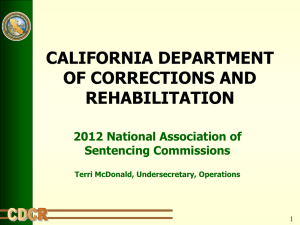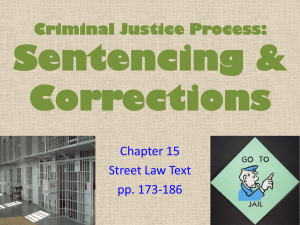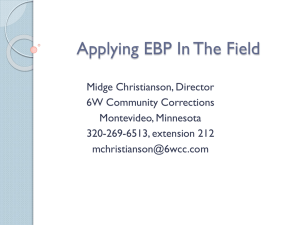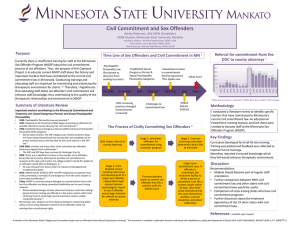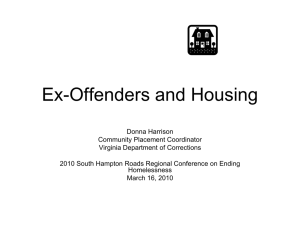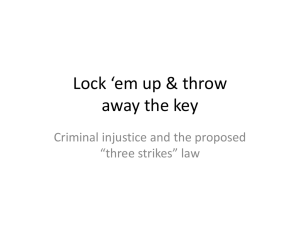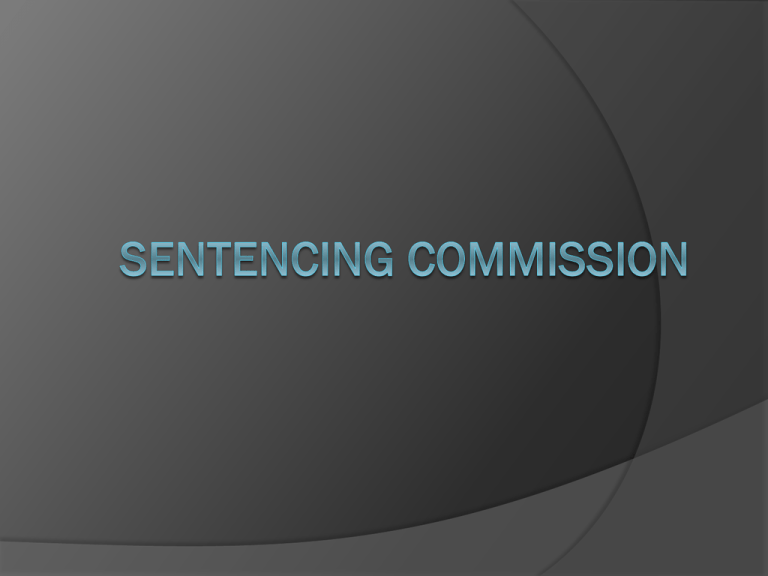
Background
The Sentencing Commission is a public governor and
legislature- appointed body whose purpose is to study
Louisiana sentencing and incarceration practices in
order to propose legislative and administrative steps to
reduce incarceration rates while also decreasing
recidivism. The Commission also educates judges,
prosecutors, defense attorneys, and probation and
parole officers about Louisiana substantive and
procedural law and criminal best practices.
The Commission’s work is currently conducted through
four workgroups: Front End, Release Mechanisms,
Reentry, and Information and technology.
Notable 2011 Reforms
Enhanced Pardon and Parole Process to aid in effective decision making
Enhanced the pardon and parole process to ensure that members of the Pardon Board and Parole
Board are equipped with the tools they need to make proper clemency decisions.
This legislation added the warden or deputy warden of the institution in which an offender is housed
as an ex officio member of the Pardon Board when that offender applies for clemency.
This enhanced the decision making process of the Pardon Board by adding a person who is in the
best position to provide information relative to the offender’s conduct while incarcerated, their
institutional adjustment and program participation.
Enhanced the Parole Board by requiring the members to complete initial training upon appointment
to the board and to complete eight hours of annual training consistent with courses offered by the
National Institute of Corrections or the American Probation and Parole Association.
Members of the Parole Board will now receive training in areas such as the parole process, use of
risk assessment tools and the dynamics of criminal victimization.
Authorized the Department of Corrections to establish a validated risk and needs assessment tool.
This tool is used to guide the department, parole board and agents of the department in determining
supervision management and strategies for offenders as well as case planning and treatment
decisions to address criminal risk factors and reduce an offenders chance of reoffending.
Created Home Incarceration Reporting Requirements:
amended the home incarceration statute to create reporting requirements for providers of home
incarceration and electronic monitoring services, so that the sentencing court, the sheriff of the
parish in which the offender is placed on supervision and the Department of Corrections will be
notified of the court’s order and will now be able to track their use.
Previously, the department had no information as to how many offenders have been sentenced to
home incarceration or electronic monitoring, or data to determine the success or failure of such
supervision. This legislation provides the department invaluable information and helps them identify
possible efficiencies for future use.
Revised and consolidated the provisions concerning “good time”
Previously, offenders earned “good time” while incarcerated for their good behavior in jail and for
participating in educational and vocational programs.
However, the multiple provisions governing “good time” made it difficult for judges, prosecutors,
crime victims and defendants to know exactly how much good time an offender would earn for any
given sentence.
This bill clarified the provisions governing this crucial area of law in our criminal justice system in
order for all stakeholders to be able to accurately determine the time an offender will serve in
prison.
Created Administrative Sanctions Process:
Created the process to allow probation and parole officers to punish probationers and parolees
with administrative sanctions for technical violations of their supervision conditions.
Administrative sanctions will reduce recidivism and ensure better compliance with supervision
conditions through quicker responses to technical violations.
Parole Eligibility for First time Felony Offenders
Previously, first time felony offenders were required to serve at least 33% of their imposed
sentence before becoming eligible for parole.
This legislation allowed first-time non-violent, non-sex offense offenders to become eligible for
parole after serving 25% of their sentence.
Notable 2012 reforms
Increased prosecutorial discretion in regard to mandatory minimums
The current criminal code provides many sentences that carry “mandatory minimums” in which an
offender must be sentenced to a term of incarceration without the benefit of probation, parole or
suspension of sentence. The code also provides for many mandatory minimum penalties and fines
that an offender must pay.
The prosecution is now able to enter into a plea agreement or post-conviction agreement with the
defendant in which they can agree to a sentence that can be served with the benefit of probation,
parole or suspension of sentence or a reduced penalty or fine. However, they cannot provide parole
benefits greater than that provided in current law.
This new ability does not apply to offenders arrested for crimes of violence or sex offenses.
Merged the pardon and parole boards and eliminated the risk review panels
In 2012, the Department of Corrections requested the Association of State Correctional Administrators
conduct a survey of other states’ pardon board structure. Of the states that responded, 19 had boards
with combined pardon and parole functions.
Statutorily moved the duties of the Parole Board and placed them under the Pardon Board. Similar to
the Ethics Board members also functioning as the Supervisory Committee on Campaign Disclosure
Laws, the Pardon Board members now function as the new “Committee on Parole” and exercise the
functions of granting or denying parole to incarcerated offenders.
Merging the parole board into the pardon board created a gross savings of over $275,000.
Risk Review Panels, were essentially an extra layer of bureaucracy in the clemency process. When a
panel determined an offender is not a risk to society, they made a recommendation that the person be
consider for parole or pardon. However, their recommendation was not binding on either the parole or
pardon board and it is not always concurred in by either board.
Furthermore, the new risk assessment tool established by a Louisiana Sentencing Commission
proposal from 2011 legislative session now objectively determine the risk posed by an offender and
whether that offender is ready to be paroled or have his sentence commuted.
Expanded re-entry courts to the 19th JDC and the 22nd JDC
This reform allowed district court judges in the 19th and 22nd judicial districts to create re-entry court divisions and
these divisions now allow offenders to participate in rehabilitation and workforce development programs taught at
Angola.
Offenders who are habitual offenders or have been convicted of a sex offense or a crime of violence are ineligible to
participate in the program.
In order to participate in the program, the offender must plead guilty and participate in the courts re-entry,
rehabilitation and workforce development program.
These programs enable offenders to learn trade skills, gain an education and develop life-skills. These offenders
are housed at Angola and taught by other offenders who have graduated from Angola’s Campus of the New
Orleans Baptist Theological Seminary or other offenders who are certified in the programs they teach.
Upon successful completion of the program, the offender petitions the court for reconsideration of sentence and the
court will then resentence the offender to probation and place him on intensive re-entry supervision.
If the offender does not succeed, then the court must sentence him to serve the remainder of his sentence in
prison.
Reduced time an offender must serve until they are parole eligible
Louisiana’s non-violent; non-sex offense offenders are a significant driver of Louisiana’s prison population. These
offenders are taking up bed space and consume resources that could be better used to target violent, high-risk
offenders and fund other priorities such as re-entry services and probation and parole supervision.
As of 11/1/10, 45% of the confined population was incarcerated because of a drug or property offense. Over 70%
of the prison admissions in calendar year 2009 were for drug or property offenses.
Previously, prior to becoming parole eligible, first time felony offenders were required to serve at least 33% of their
imposed sentence, second time felony offenders were required to serve 50% of their imposed sentence and third
time felony offenders were not eligible for parole.
Parole eligibility only gives the offender a hearing before the parole board, and does not guarantee they will be
released from prison. The current grant rate of the parole board is about 30%.
Good Time calculation revision
This legislation altered the computations of time to allow non-violent offenders to serve 6% more of their sentence
on parole supervision rather than in prison (from 54% to 60% of the total sentence on supervision). These
offenders previously earned good time at a rate of 35 days for 30 days, and this reform changed this to earning
good time at a rate of 1.5 days for 1 day. Essentially, these offenders now spend about an extra 22 days per year
on parole supervision.
Notable 2013 Reforms
Created Early Release program for certain
Drug Offenders
Authorized the Secretary of DOC to grant
Early/Conditional release to first, or second offenders
currently incarcerated for possession or possession with
intent to distribute drugs to intense parole supervision who
meet the following criteria:
○ Non-Sex, Non-Violent, First and Second Offenders (for
possession or possession with intent to distribute
controlled dangerous substances-), who have served at
least 2 years (as of 7/1/2013) and
○ whose release date is within ONE year
○ Successful completion of a 90 day chemical
dependency treatment program prior to the scheduled
early release.
Authorized DOC to create a Substance Abuse
Probation Program for certain eligible Drug
Offenders
The program model requires judges to suspend a
sentence and place an offender on probation with
treatment as a condition of probation for certain offenders
meeting a series of eligibility criteria
The DOC monitoring and treatment program is closely
modeled after the Drug Court Probation program- using
third party substance abuse treatment providers as well as
Administrative Sanctions to mirror the Drug Court’s swift
accountability and graduated sanctions.
Eliminated certain restrictions on eligibility for
consideration for Drug Court
Attempted Theft
Amended the attempt theft statute (R.S. 14:27) to make the
threshold amounts for a particular sentence consistent with that for
the theft statute (R.S. 14:67). Before this bill the threshold for
attempted theft was lower than for the completed offense
Simple Escape
Eliminates the mandatory consecutive sentencing for the simple
escape from work release (transitional work program) returning
discretion to the sentencing judge.
OWI
This bill permits OWI (R.S. 14:98) offenders to be sentenced through
a drug court model and made adjustments to the administrative
proceedings
Risk/Need Assessment at Sentencing (Pilot program in the 22nd
JDC)
This instrument sets up a pilot program in the Twenty-Second
Judicial District Court for the use of a validated risk/needs
assessment tool pre sentence for use by the court in sentencing.
Areas of Interest for 2013/2014
Parole Eligibility for Elderly offenders
Medical Parole for certain terminally ill
inmates
Mandatory Minimums
Expansion of Drug Court Eligibility
Cleansing Period for 3rd offenders
Continue to research and collect data
regarding factors driving Louisiana’s
incarceration and recidivism rates.


